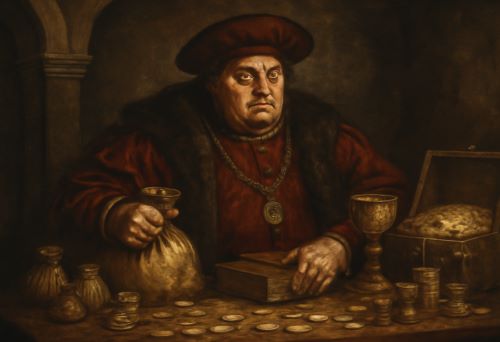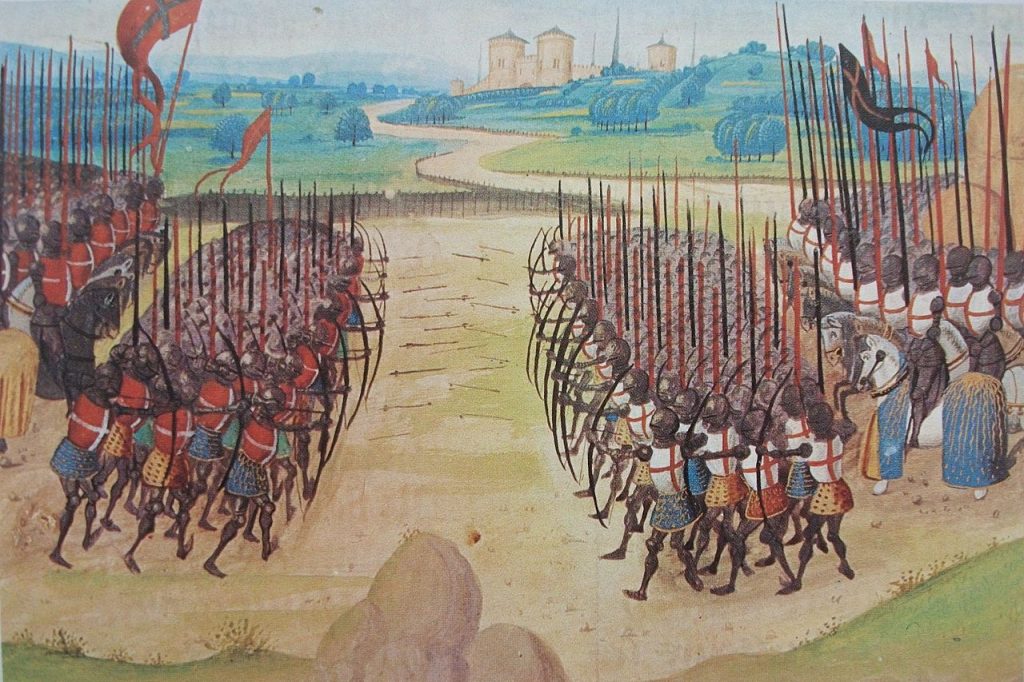

Wealth and power were built on the exploitation of the lower classes.

By Matthew A. McIntosh
Public Historian
Brewminate
Introduction
The medieval period, spanning roughly from the 5th to the 15th century, was characterized by an entrenched system of social, economic, and political hierarchies. The wealth accumulated by certain classes and individuals in this era, particularly the nobility, clergy, and monarchs, was often achieved through the exploitation and abuse of the lower classes. While many of the wealthy in medieval society lived in grandeur, their wealth was often built on practices that would be considered abusive by modern standards—such as serfdom, exploitation of peasantries, and manipulation of legal and religious systems. Let’s look to how medieval wealth was accumulated through abusive practices, focusing on land ownership, the role of the Church, and the use of political power to maintain and increase wealth.
The Foundation of Medieval Wealth: Land Ownership and Feudalism
At the heart of medieval wealth was the feudal system, a hierarchical structure where land was the primary source of wealth and power. Under feudalism, kings granted large estates to nobles and knights in exchange for military service, while peasants (serfs) worked the land and provided food and resources in return for protection and a place to live. This system created a stark disparity between the land-owning aristocracy and the laboring peasantry, allowing the elite to amass significant wealth through the exploitation of the lower classes.
Land ownership, in the feudal system, was not just a means of earning wealth—it was the basis of power. The manorial system, which governed rural economies, allowed landowners to control vast tracts of land, and thus, the lives of those who worked it. In exchange for small plots of land to farm for their own subsistence, peasants were required to give a significant portion of their crops to the lord, often 30–50%, and to pay additional taxes. Moreover, the feudal lords had the right to impose corvée labor, where peasants were forced to work on the lord’s lands for a certain number of days each week without pay, often to maintain the lord’s estate or perform other menial tasks. This system ensured the wealth of the landowners but kept the peasants in a cycle of poverty and labor.
Feudal lords also exercised judicial power, using it to extract additional wealth from the serfs. They had control over local courts and could impose fines and taxes for minor infractions. The wealth generated from these practices was often used to fund military campaigns, fortify castles, and secure further lands, creating an entrenched system of wealth that benefited the elite and further impoverished the lower classes.
The Church as a Wealthy Power Broker

While the nobility amassed wealth through land and labor, the Catholic Church in medieval Europe also became one of the wealthiest institutions of the period. The Church’s wealth grew in part through land ownership, but also through its spiritual authority, which enabled it to amass vast fortunes from the faithful. One of the key sources of the Church’s wealth was its tithe, a mandatory payment that required peasants and even wealthy landowners to donate a portion of their income (usually 10%) to the Church. The Church also received donations from individuals seeking salvation, and it built its own vast estates, often taking land from secular rulers.
In addition to its role in land ownership, the Church exploited its influence over the population by manipulating religious guilt and promising salvation in exchange for donations. One of the most egregious examples of this is the practice of indulgences, where individuals could buy forgiveness for their sins and reduce their time in purgatory. This practice was particularly rampant in the later medieval period, leading to widespread corruption within the Church. Wealthy individuals could literally buy their way out of penance, ensuring that the Church continued to accumulate riches while remaining largely beyond reproach.
The clergy, including bishops and abbots, often lived lives of luxury, collecting rents from the lands they owned and enjoying privileges denied to commoners. This led to resentment from the lower classes, especially when the Church’s wealth was used to fund elaborate cathedrals and the opulent lifestyles of high-ranking clergy, rather than being redistributed to the poor.
Monarchs and the Abuse of Power
Medieval monarchs also played a significant role in the accumulation of wealth, often through taxation and exploitation of their subjects. Kings collected taxes on land, goods, and services, which were often harshly imposed and disproportionately affected peasants and the lower classes. Kings also had the power to sell positions in their courts or grant land and titles in exchange for bribes or loans, which perpetuated the cycle of wealth accumulation by the elite. Furthermore, monarchs often engaged in warfare to expand their territories and wealth, a practice that led to the displacement and suffering of common people. During times of war, monarchs would levy high taxes on their subjects to fund military campaigns, further tightening their control over the peasantry while simultaneously increasing their wealth.
The most famous example of abusive wealth and political manipulation during the medieval period can be found in the reign of King John of England. His heavy taxation, coupled with his corrupt dealings with the nobility, led to widespread discontent and, eventually, the signing of the Magna Carta in 1215. This document, which limited the king’s power and placed certain legal constraints on him, was the result of decades of abuses, including the extraction of wealth through illegal taxation and the manipulation of feudal law to benefit the monarchy and his favored courtiers.
The Role of Wars and Military Campaigns in Wealth Accumulation

Military campaigns played an essential role in the creation of wealth for many medieval rulers, and the accumulation of spoils from war was often a direct means by which monarchs and noble families expanded their wealth. Crusades—the series of religious wars launched by Christian Europe against Muslim-controlled territories—were a key vehicle for this process. Wealthy nobles, eager to gain land and riches, participated in the Crusades, often at the cost of common soldiers, who were promised rewards that they rarely saw. The loot captured during these campaigns—ranging from gold and silver to land and slaves—was distributed among the nobility, while the common soldiers typically returned empty-handed.
Similarly, the Hundred Years’ War between England and France (1337-1453) created vast opportunities for the nobility to gain wealth through military conquests. Both sides relied heavily on the exploitation of the lower classes to fund their military endeavors. The English, for example, imposed harsh taxes on their subjects to finance the war, while the French nobility gained enormous wealth from the lands they seized during the conflict. These wars left much of the peasantry in debt, destitution, and even slavery, further reinforcing the wealth disparity between the elite and the common people.
Conclusion: Medieval Wealth and the Cycle of Abuse
The medieval period was a time when wealth and power were built on the exploitation of the lower classes, from the feudal lords who controlled vast estates through serfdom to the Church’s manipulation of religious authority to accumulate riches. Monarchs and the military elite also contributed to this cycle of exploitation through taxation, bribery, and the spoils of war. The wealthy, both secular and religious, lived in opulence, while the majority of the population—comprising peasants, serfs, and common soldiers—lived in squalor and debt, bound to their land and masters.
Medieval wealth was often abusive not only because it was concentrated in the hands of a few but also because it was derived from systems that systematically oppressed and exploited the vast majority of society. The hierarchical structures of feudalism and the Church’s control over spiritual and material wealth created an environment where the elite were able to accumulate wealth while the lower classes bore the brunt of their abuse. This system of exploitation and inequality was deeply entrenched in medieval society, leading to a cycle of wealth accumulation that depended on the suffering and subjugation of others.
Appendix
Endnotes
- John Gillingham, The English in the Twelfth Century: Imperialism, National Identity, and Political Values (Woodbridge: Boydell Press, 2000), 95.
- John Hatcher, The Black Death: A Personal History (New York: HarperCollins, 2008), 12.
- Ernst H. Kantorowicz, The King’s Two Bodies: A Study in Mediaeval Political Theology (Princeton: Princeton University Press, 1957), 214.
- C.S. Lewis, The Discarded Image: An Introduction to Medieval and Renaissance Literature (Cambridge: Cambridge University Press, 1964), 76.
- J.E. Powell, Medieval Christianity and the Rise of the European World (New York: Viking Press, 1991), 53.
Bibliography
- Gillingham, John. The English in the Twelfth Century: Imperialism, National Identity, and Political Values. Woodbridge: Boydell Press, 2000.
- Hatcher, John. The Black Death: A Personal History. New York: HarperCollins, 2008.
- Kantorowicz, Ernst H. The King’s Two Bodies: A Study in Mediaeval Political Theology. Princeton: Princeton University Press, 1957.
- Lewis, C.S. The Discarded Image: An Introduction to Medieval and Renaissance Literature. Cambridge: Cambridge University Press, 1964.
- Powell, J. E. Medieval Christianity and the Rise of the European World. New York: Viking Press, 1991.
Originally published by Brewminate, 07.07.2025, under the terms of a Creative Commons Attribution-NonCommercial-NoDerivatives 4.0 International license.


